
Posted on 08/20/2014 4:16:47 AM PDT by Homer_J_Simpson

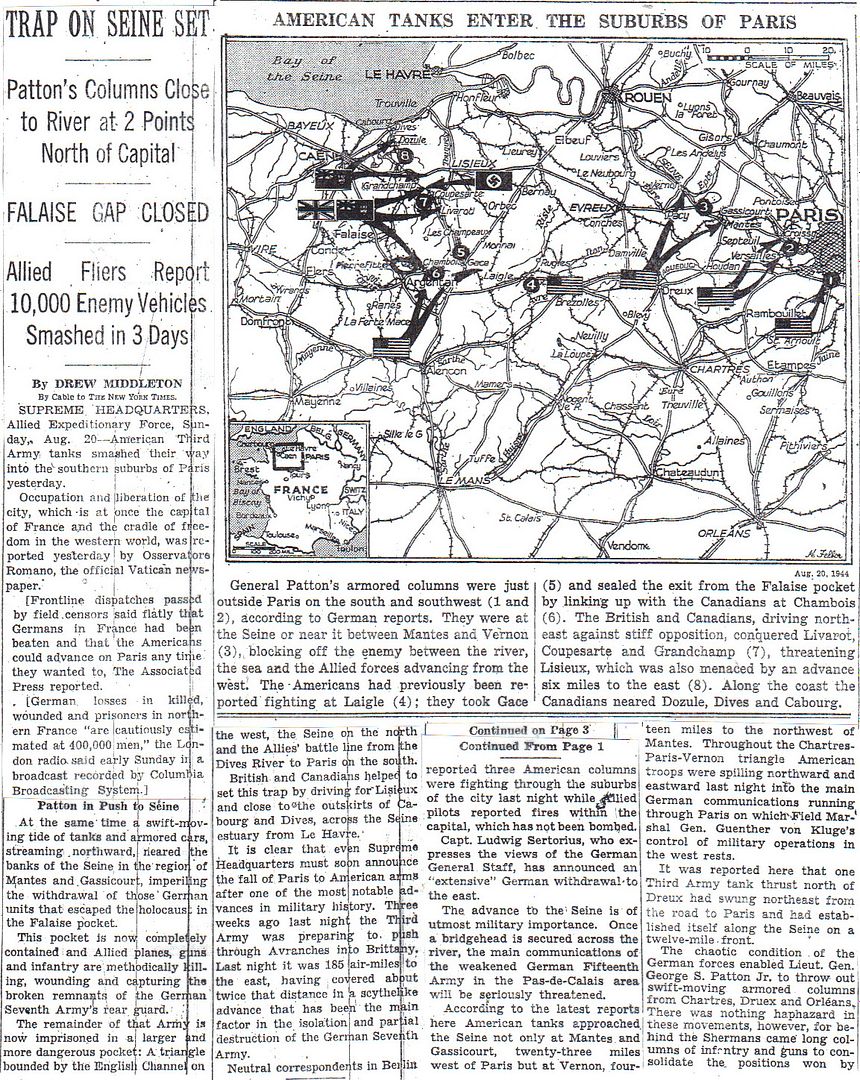
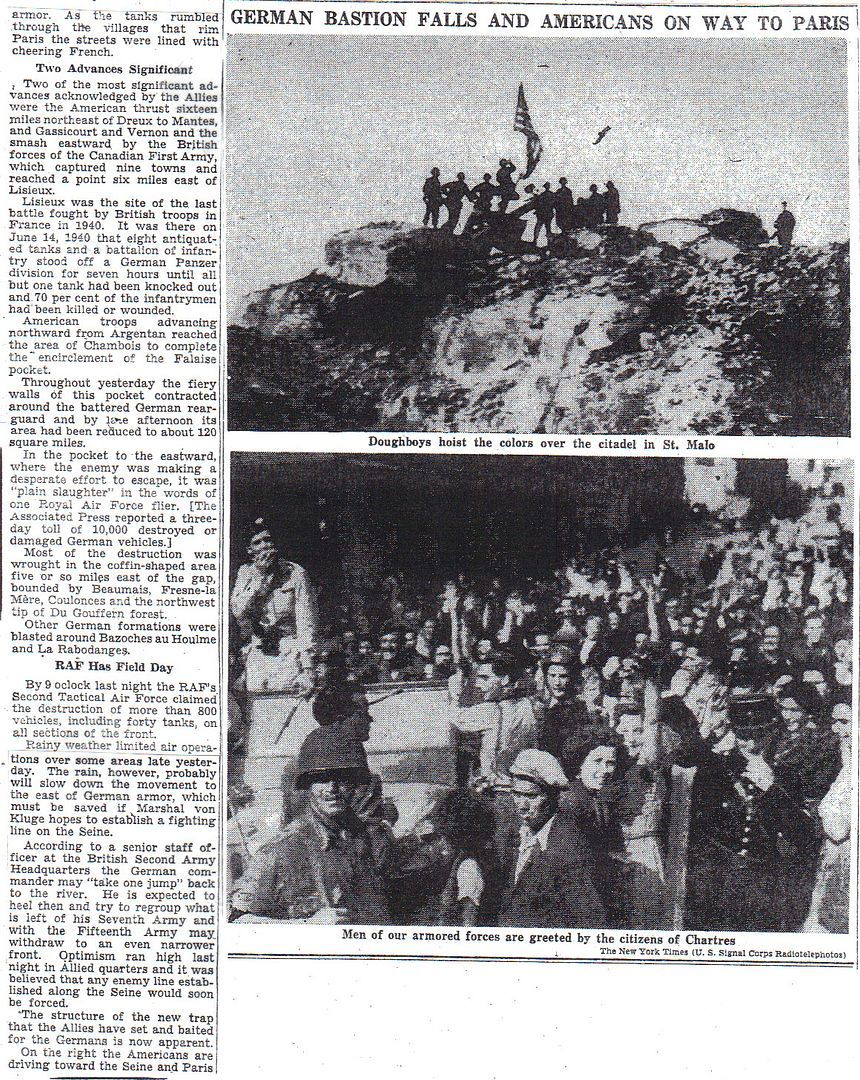
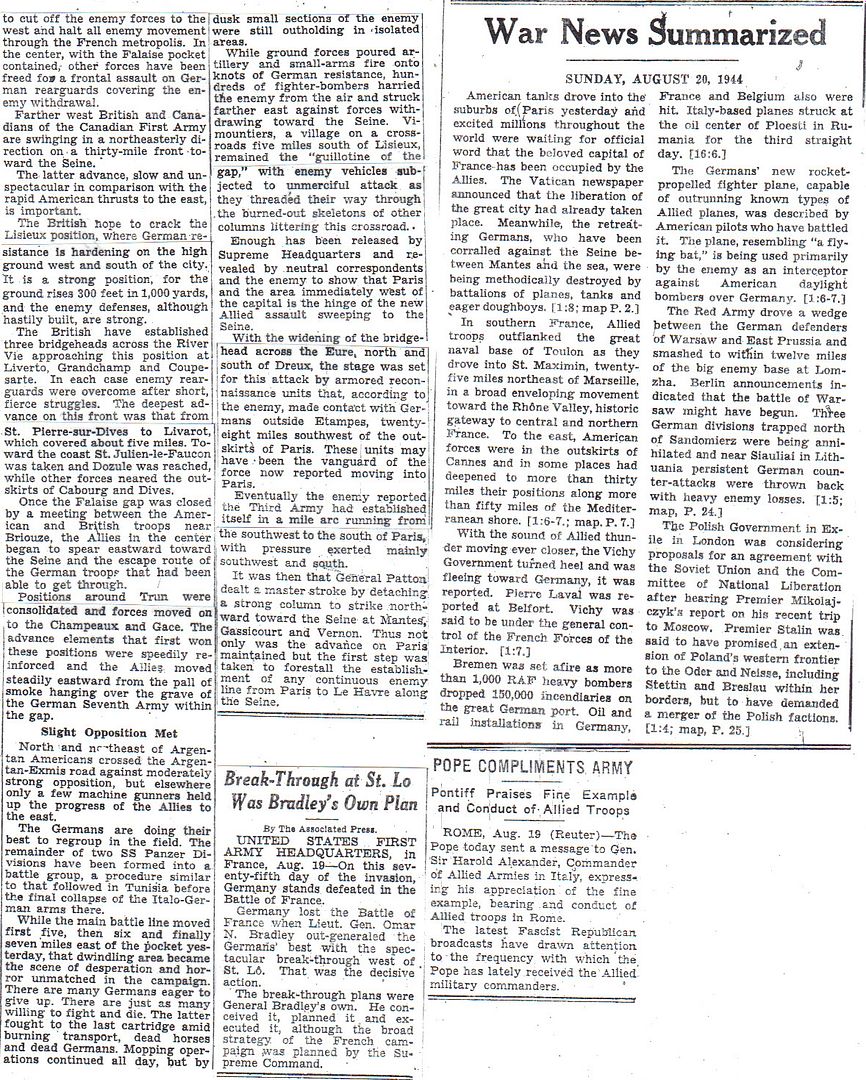
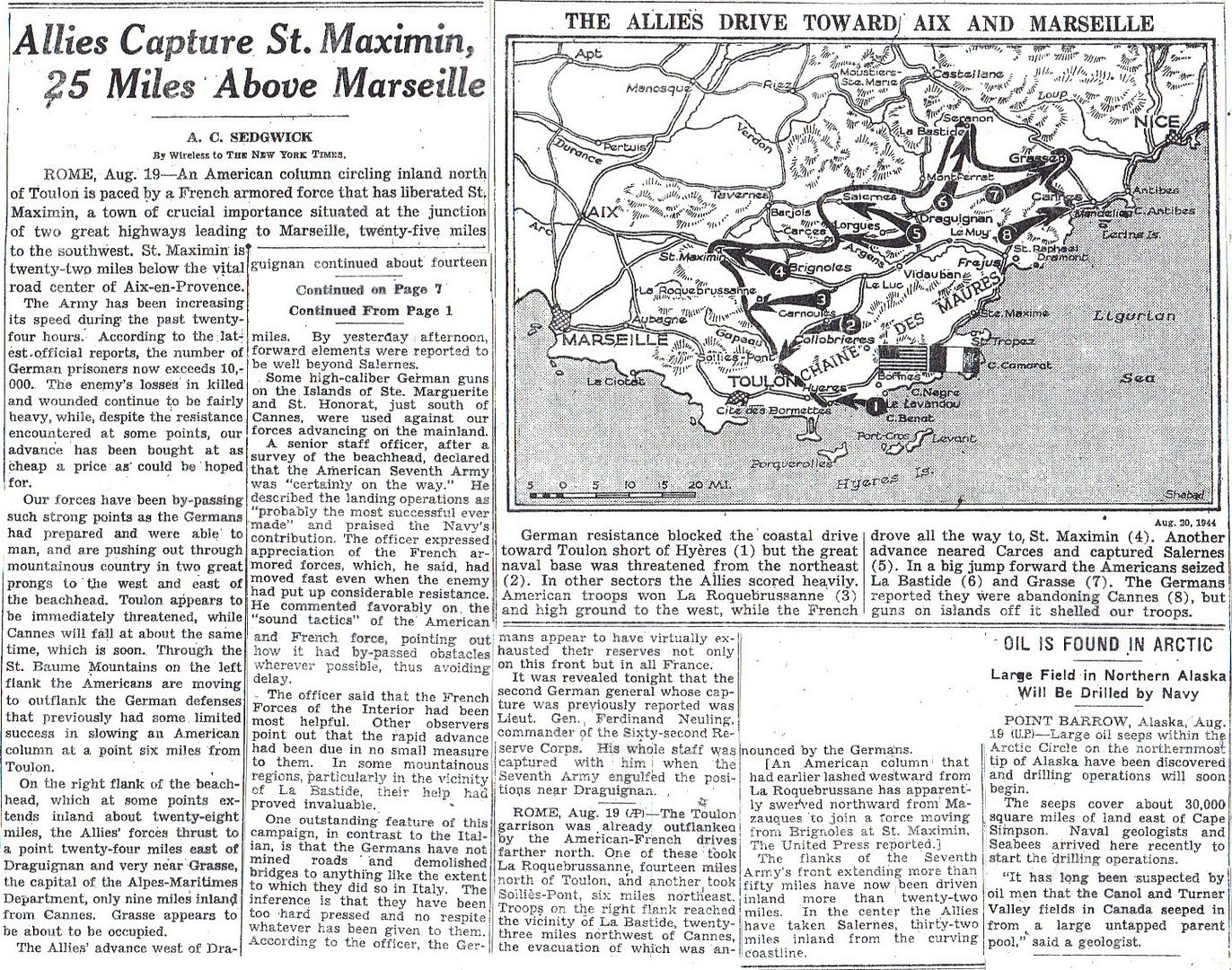
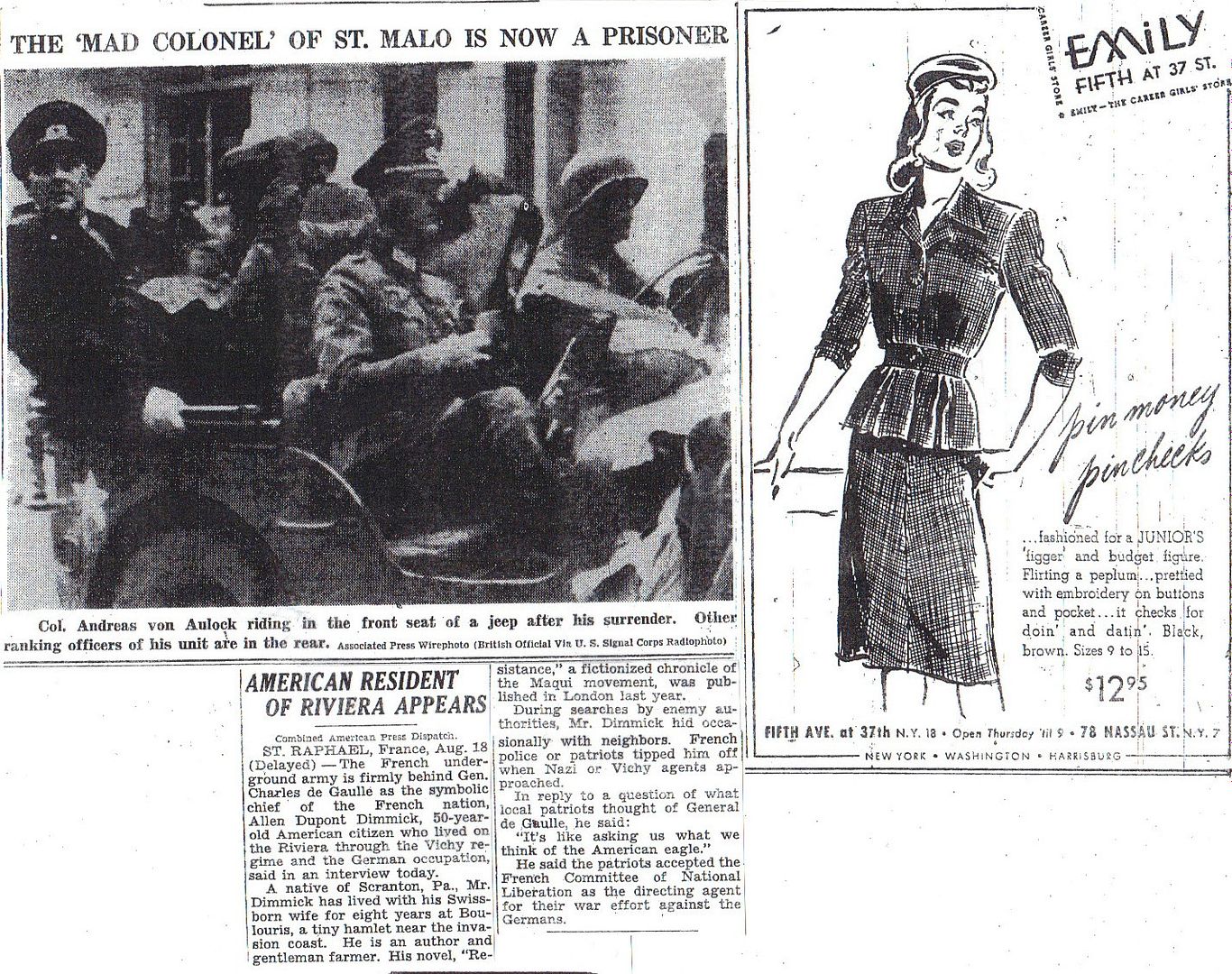
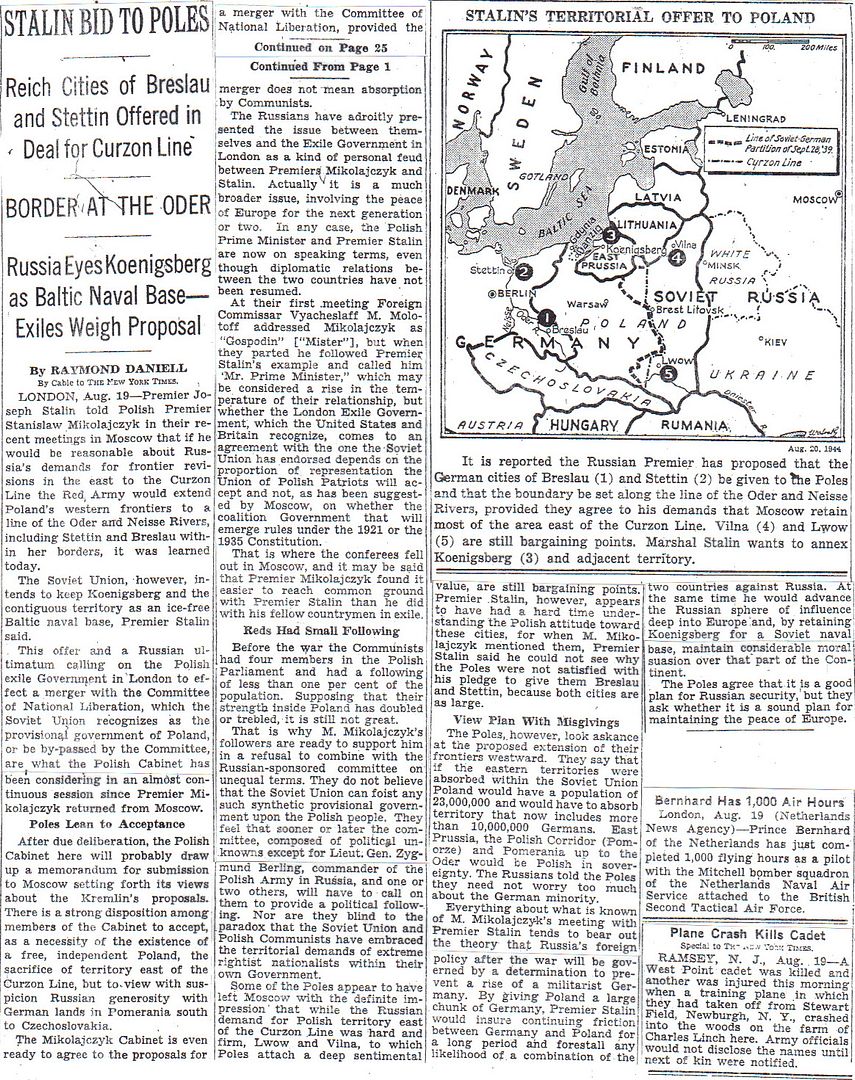
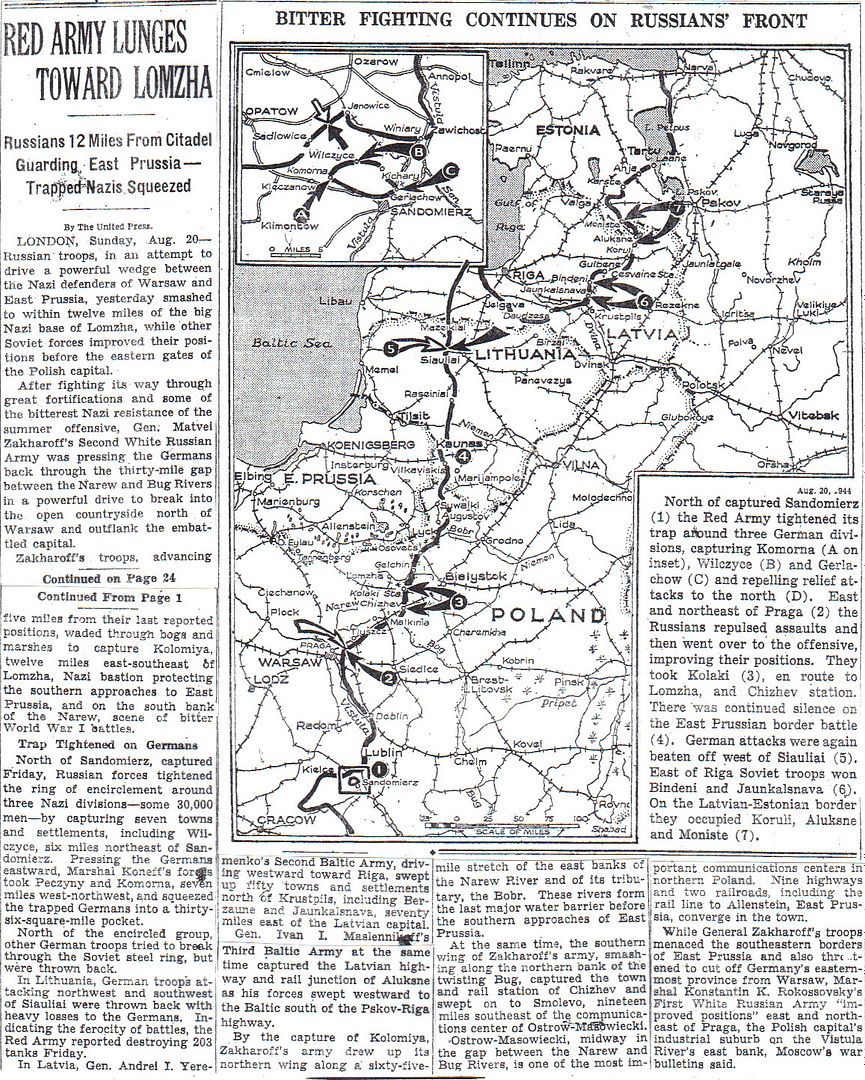
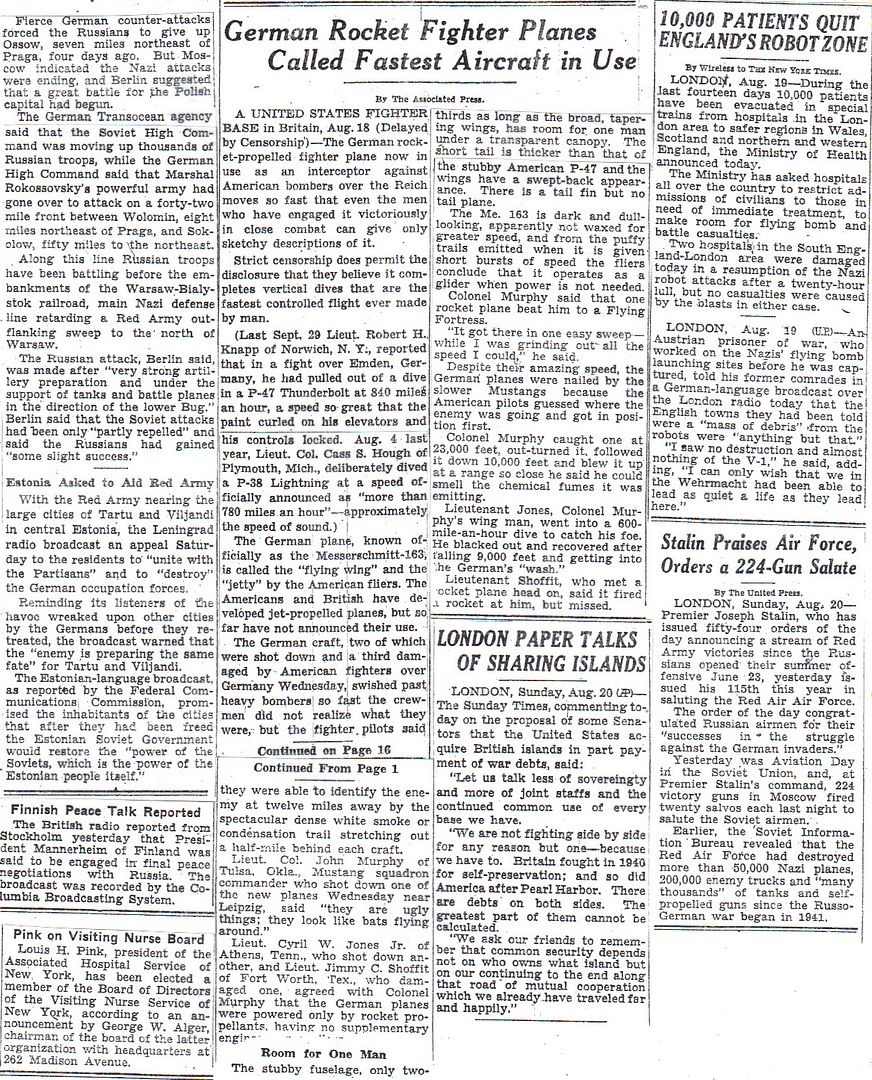

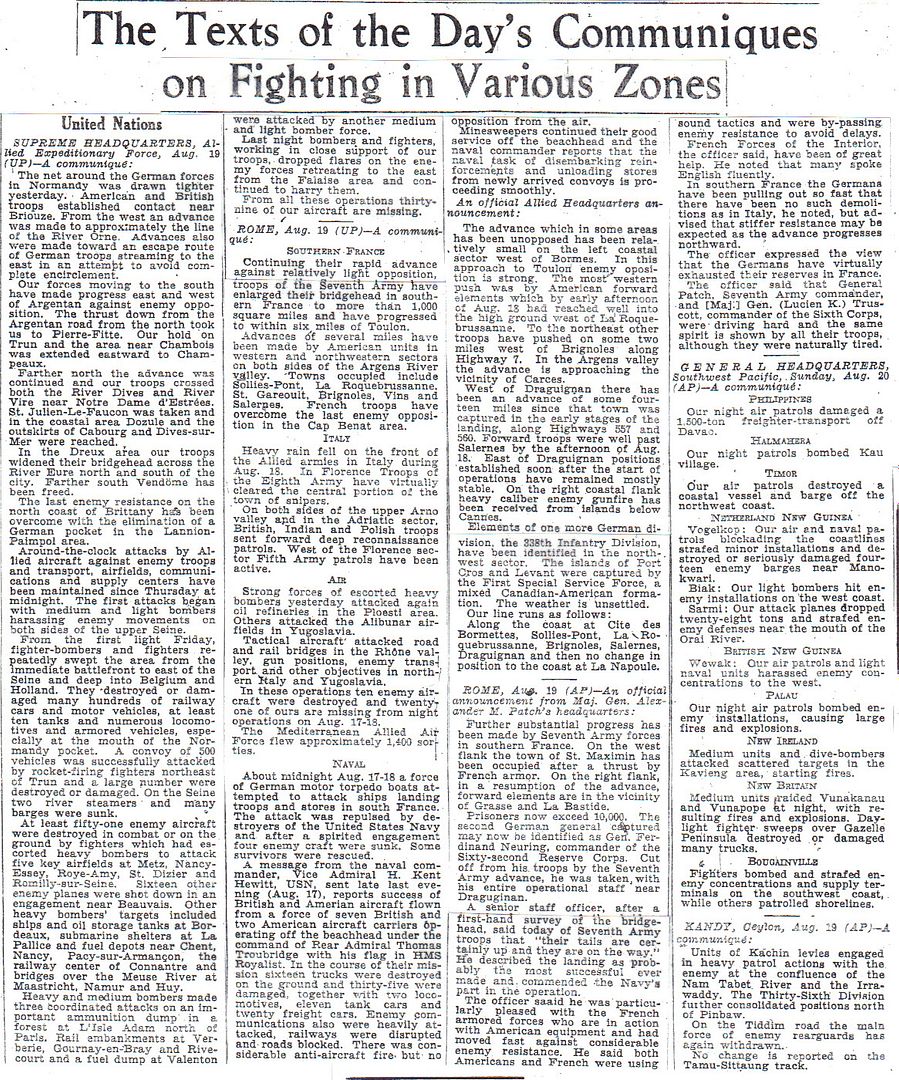
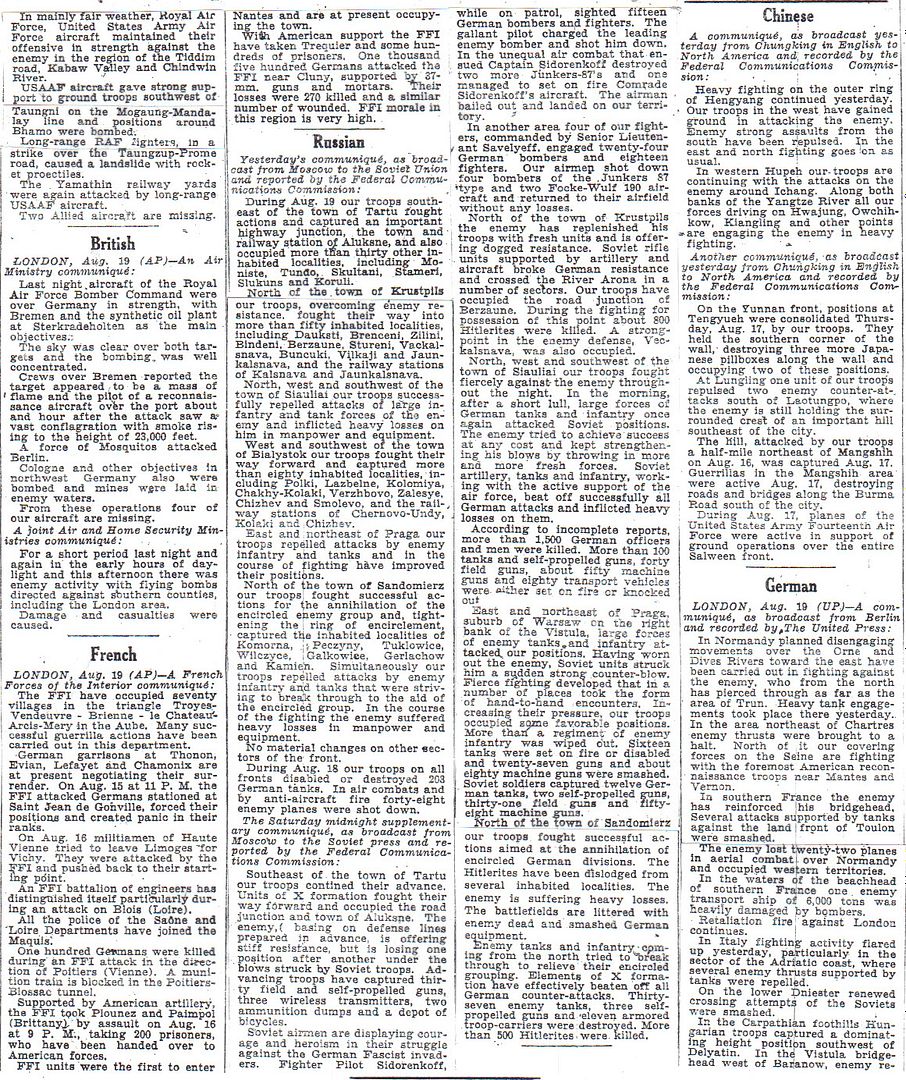
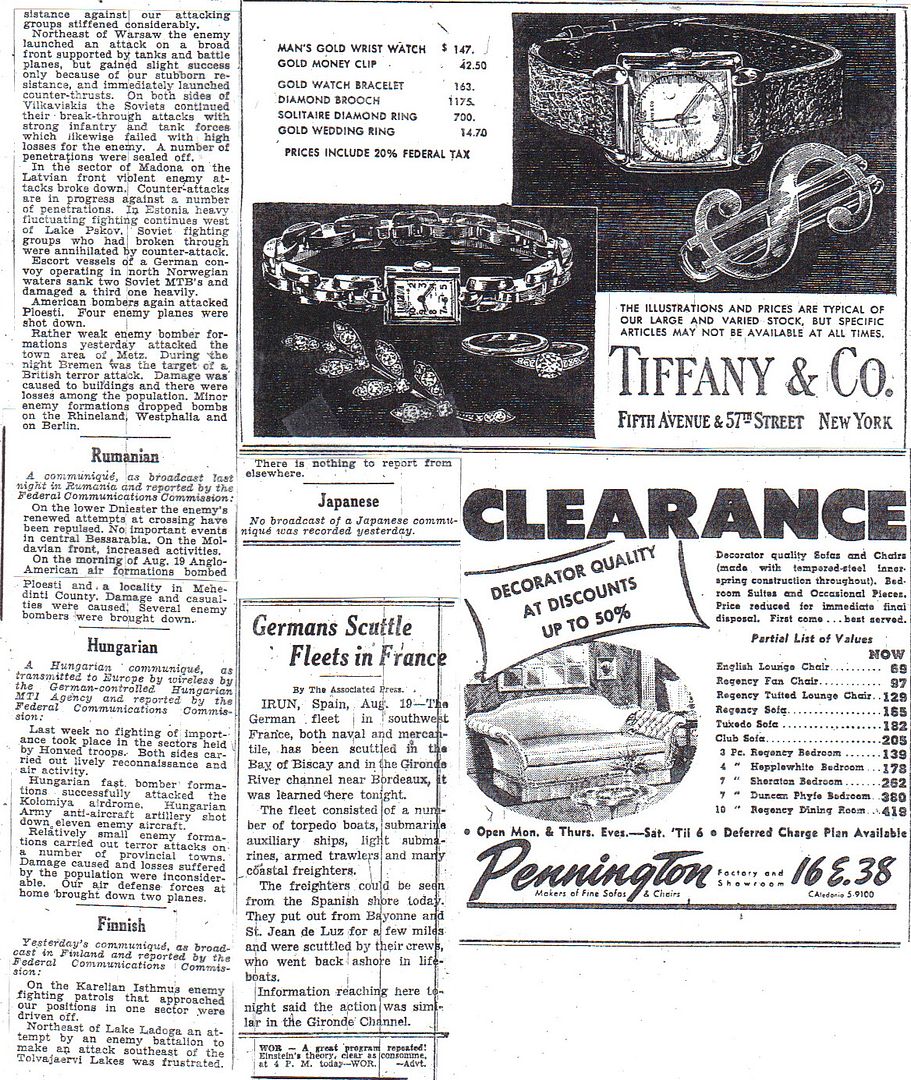
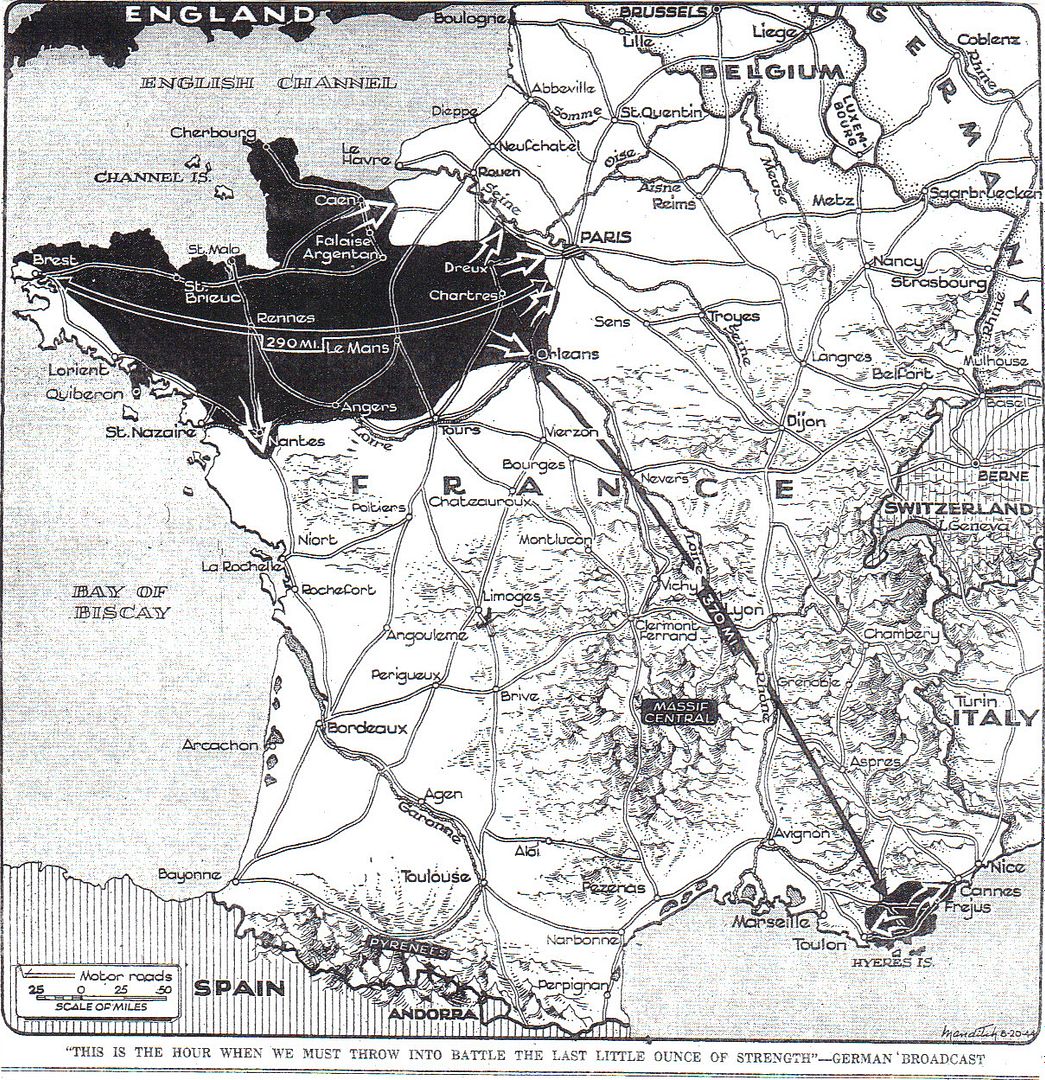
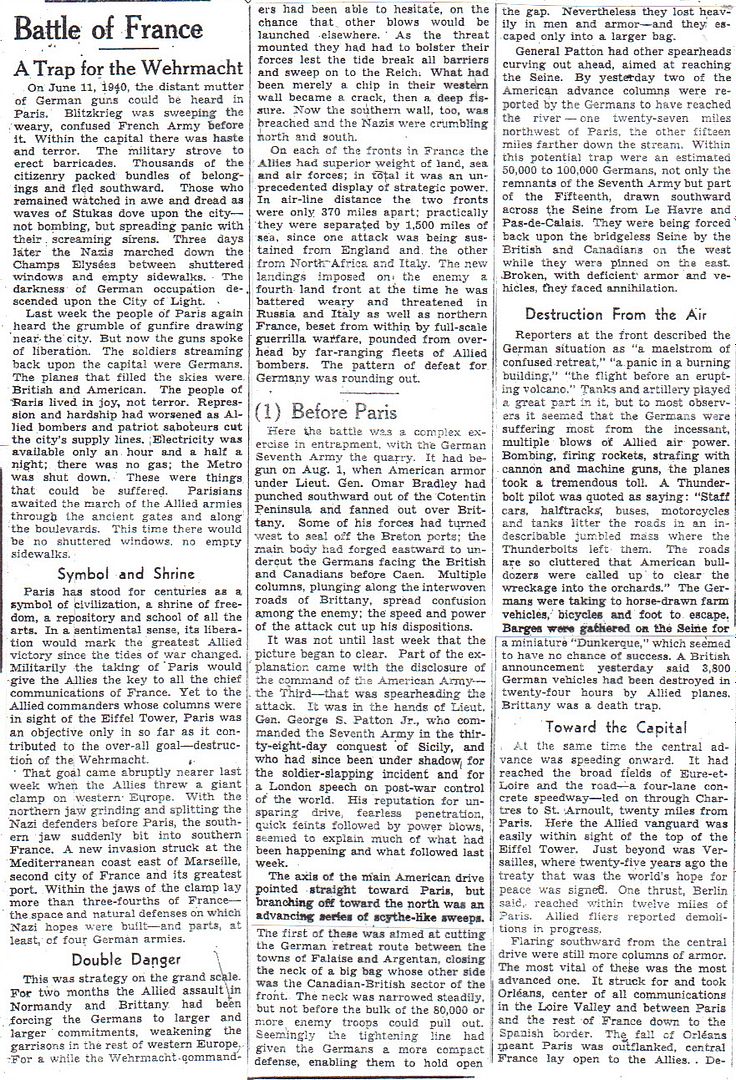
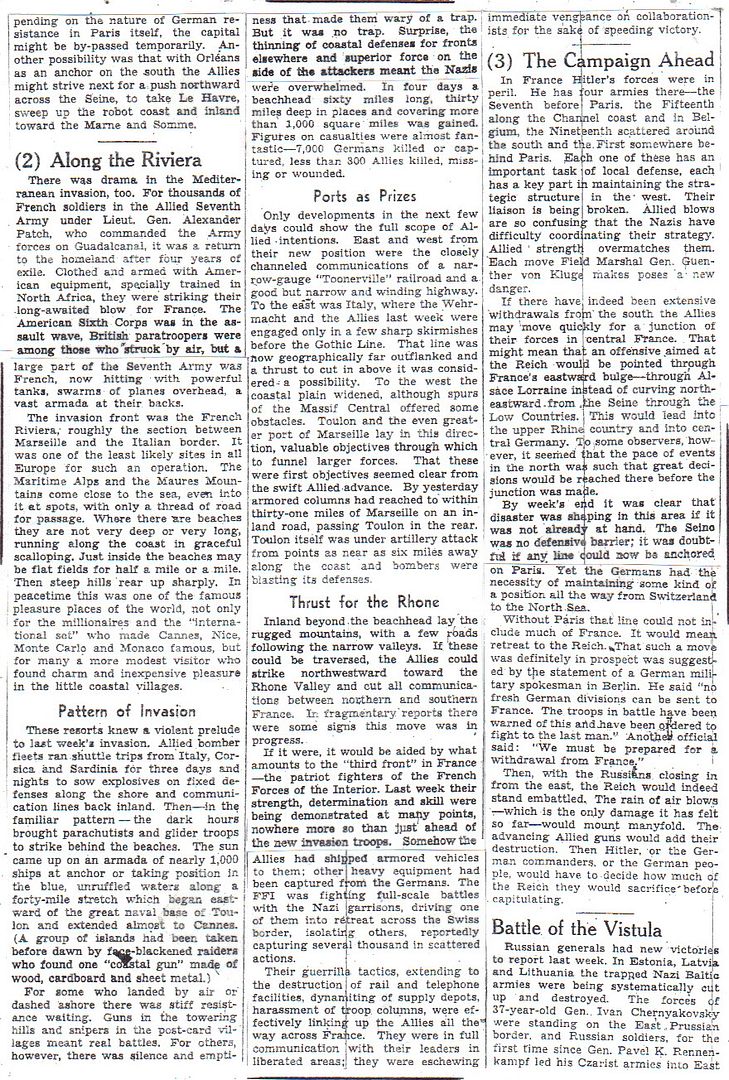
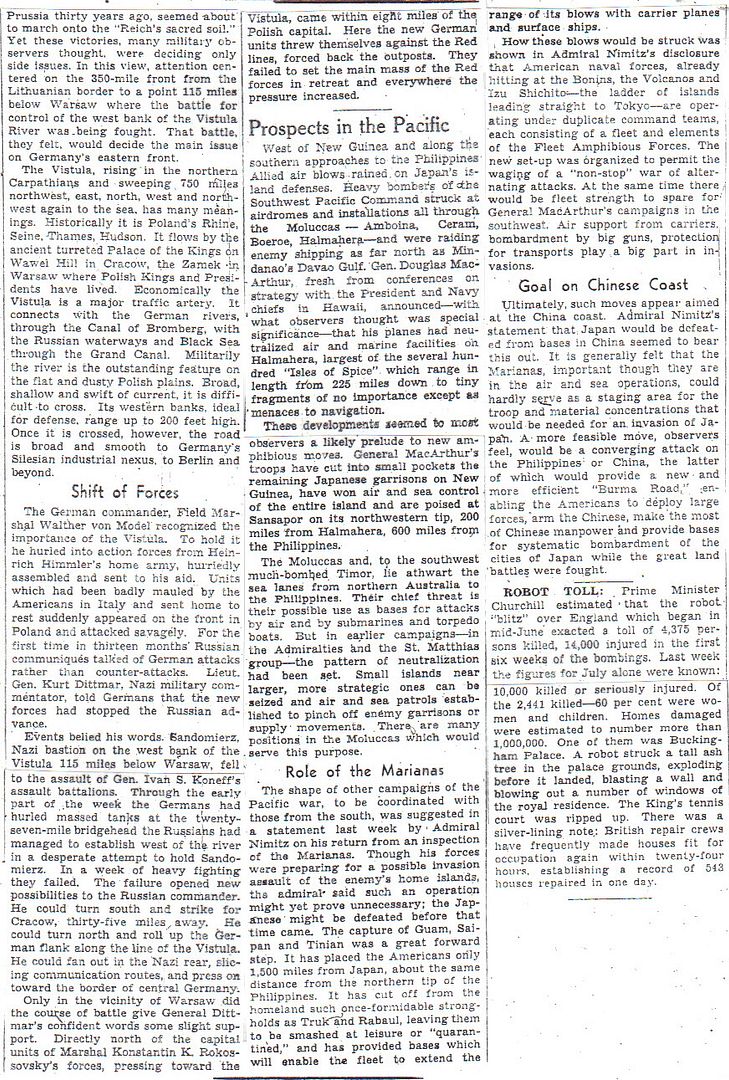
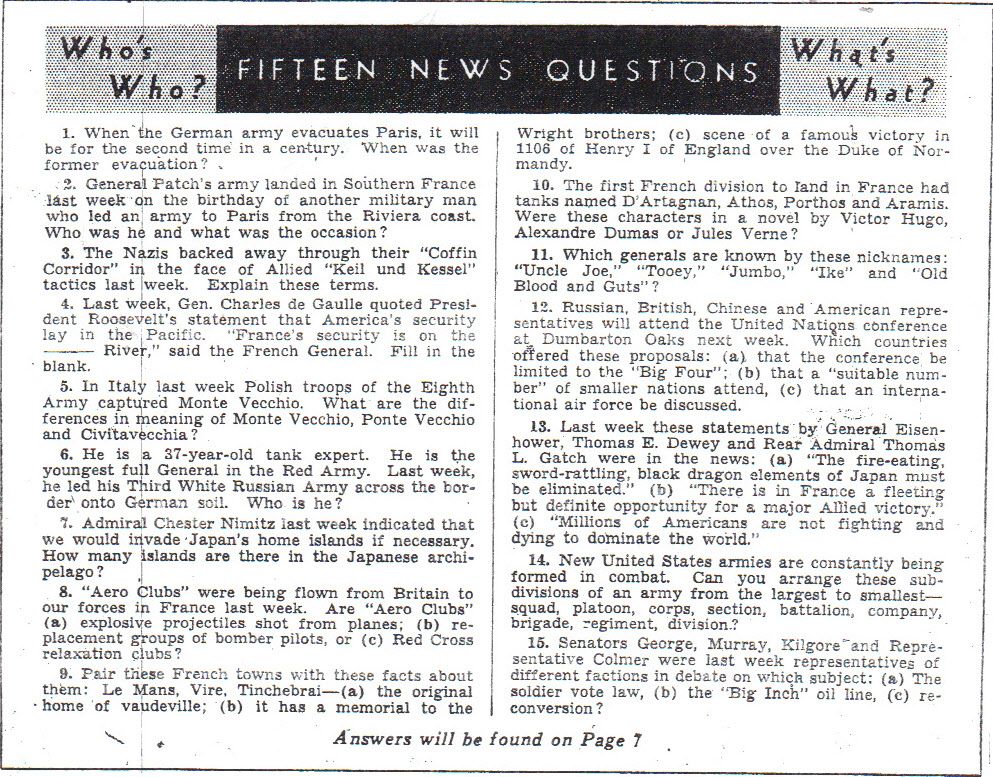

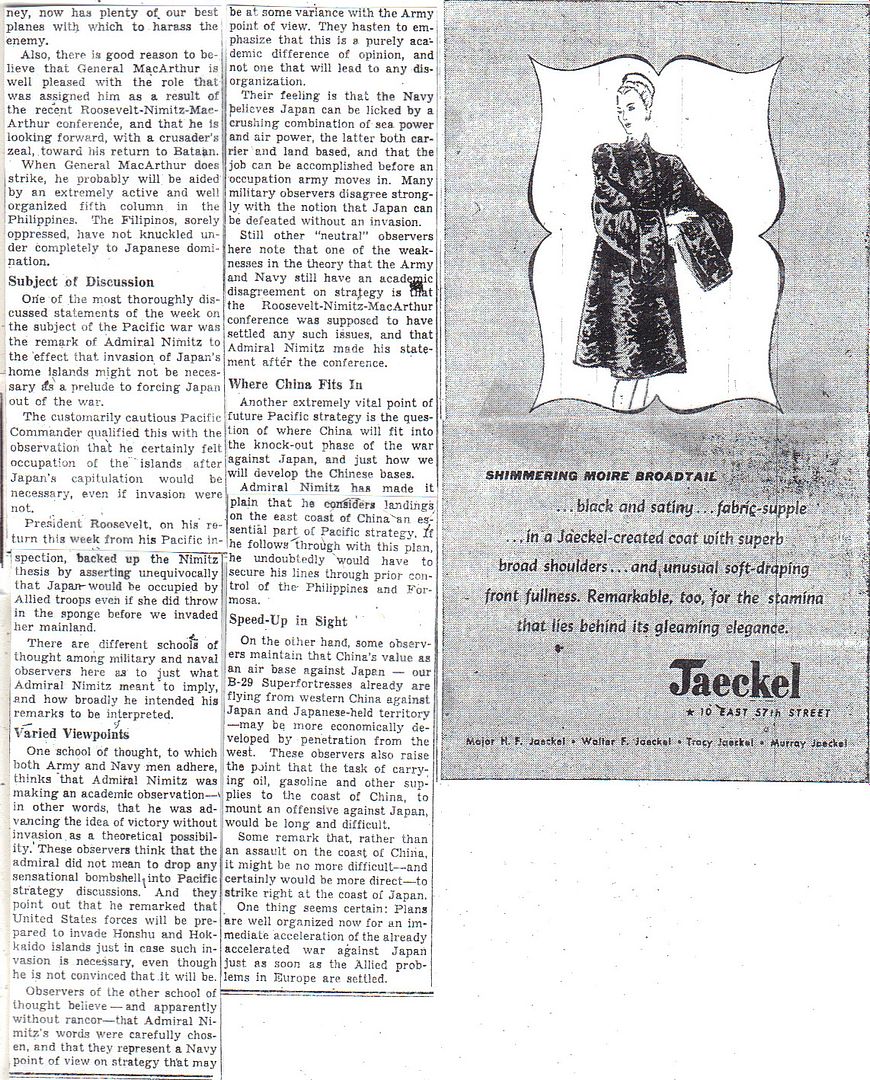

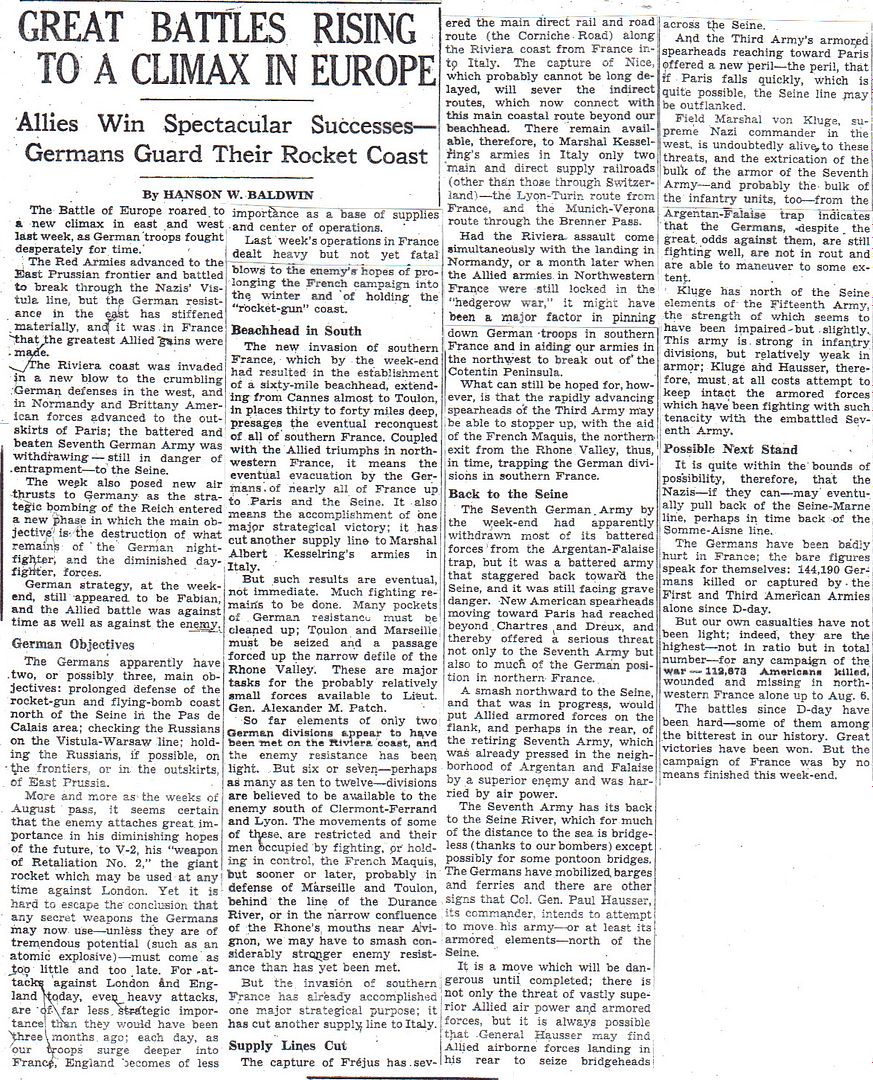

Two days later we sent the following joint appeal, which the President had drafted:
Prime Minister (Italy) and President Roosevelt to Marshal Stalin 20 Aug 44
We are thinking of world opinion if the anti-Nazis in Warsaw are in effect abandoned. We believe that all three of us should do the utmost to save as many of the patriots there as possible. We hope that you will drop immediate supplies and munitions to the patriot Poles in Warsaw, or will you agree to help our planes in doing it very quickly? We hope you will approve. The time element is of extreme importance.
Winston S. Churchill, Triumph and Tragedy
The News of the Week in Review
“This is the Hour when We Must Throw into Battle the Last Little Ounce of Strength”-German Broadcast (map) – 14
Battle of France – 15-17
Fifteen News Questions – 18
Our Pacific Strategy Nears Its Final Stage (Shalett) – 19-20
Allied Armies Drive Ahead in the Battle of Europe (map) – 21
Great Battles Rising to a Climax in Europe (Baldwin) – 22
“Two-Pronged Attack Does It” (cartoon) – 23
Answers to Fifteen News Questions – 23
http://www.onwar.com/chrono/1944/aug44/20aug44.htm#
Germans defending Riga
Sunday, August 20, 1944 www.onwar.com
On the Eastern Front... In Latvia, Soviet attacks continue. Naval support from the German heavy cruiser Prinz Eugen assists Army Group North in holding a Soviet advance near Riga. In the south, a large-scale artillery barrage during the night heralds a new Soviet offensive. The 2nd Ukrainian Front (Malinovsky) advances south from Jassy and the 3rd Ukrainian Front advances southwest from Tiraspol. The Romanian 3rd and 4th Armies, on the right and left flanks of German 6th Army are the initial targets of the assault.
On the Western Front... During the night, the last elements of German 5th Panzer and 7th Armies to escape the Falaise pocket filter through Allied line around Chambois and St. Lambert. Some 70-80 miles to the east, the US 3rd Army captures crossings over the Seine River at Mantes Grassicourt, 30 miles west of Paris. To the southwest of Paris, the US 20th Corps (also part of US 3rd Army) enters Fontainbleau.
In Occupied France... Marshal Petain is arrested by Germans in Vichy for refusing to go to an area safe from the Allied advance. The French resistance forces (FFI) claim to control 8 departments.
In Liberated France... General de Gaulle arrives.
In New Guinea... Americans announce that Japanese resistance on Biak Island has ended. The Japanese have suffered 4700 killed and 220 captured. US casualties are listed at 2550.
I doubt it.
http://www.etherit.co.uk/month/thismonth/20.htm
August 20th, 1944 (SUNDAY)
ENGLISH CHANNEL: - U-413 is sunk south of Brighton, in position 50.21N, 00.01W, by depth charges from the RN escort destroyer HMS Wensleydale and the destroyers HMS Forester and HMS Vidette. Only 1 of the 46 crewmen of the U-boat survived.
FRANCE:
- 61 US Ninth Air Force B-26s bomb troop and equipment concentrations waiting at Foret de la Lande to be ferried across the Seine River; fighters fly armed reconnaissance along the Seine River, support ground troops in the battle area of northern France, and fly an escort mission to 100+ C-47 Skytrains on a supply and evacuation run.
- In southern France during the night of 19/20 August, US Twelfth Air Force A-20 Havocs attack lights and motor transport from the battleline northwest to the Rhone River; B-26s, joined by fighter-bombers and fighters, hit coastal defence guns in the Toulon area, while B-25s bomb Rhone Valley bridges and airfields achieving especially good results at the airfield near Valence.
Falaise: Fighting is at its fiercest, as the German Seventh Army tries to break out of the “pocket” to join the SS 2nd Panzer Division at Mont Ormel.
Last night the last units of the German 5th Panzer and 7th Armies escape from the Falaise pocket through the Allied lines around Chambois and St. Lambert.
Patton takes crossings on the Seine River at Mantes Grassicourt, 30 miles west of Paris. The XX Corps enters Fontainebleau.
- U-188 is scuttled at the U-boat base in Bordeaux when it is unable to escape the Allied advance.
Petain is arrested by the Germans in Vichy for refusing to go to an area which is safe from the Allied advance.
Paris: The Hôtel de Ville is taken over by the FFI. The mobilization of the FFI is described thus: “An officer was told by a double agent that two trucks were broken down at Levallois; they were attacked and their drivers killed; the spoils were fruitful: 4 machine guns, 12 submachine guns, 250 pistols, and some ammunition boxes. At Clichy two German trucks collided at the angle of the boulevard Victor-Hugo and the boulevard Jean-Jaurès, and 9 machine guns, 15 submachine guns, and 8 Mausers were made away with. Next day, 20 submachine guns were taken from the Hotchkiss factory as well as a truckload of long-handled grenades on the quai de Saint-Ouen. So the insurgents,..., reached a strength of seven to eight thousand armed combatants for the liberation.”
Since the main roads are clear, and German patrols are able to pass freely up and down them, von Cholitz feels no call to intervene; the occupation of the Préfecture de Police and Hôtel de Ville are without strategic significance. At the demand of the non-Communist resistance and through the good offices of Nordling, the Swedish consul general a truce is arranged.
GERMANY: U-3513 laid down.
In east central Europe, the US Fifteenth Air Force in Italy dispatches 460+ B-24s and B-17s, some fighter-escorted, to bomb the airfield and marshalling yard at Szolnok, Hungary and oil refineries at Dubova, Czechoslovakia, and Czechowice and Auschwitz, Poland.
CZECHOSLOVAKIA:Seventy six USAAF Fifteenth Air Force B-24 Liberators bomb the oil refinery at Dubrova without loss.
HUNGARY: USAAF Fifteenth Air Force B-24 Liberators attack three targets: 94 aircraft bomb the marshalling yard at Szolnok, 88 bomb Rakoczifalva Airfield at Szolnok with the loss of two aircraft, and six bomb the city of Szeged.
POLAND: Two hundred twelve USAAF Fifteenth Air Force B-17 Flying Fortresses bomb the I.G. Farben oil refinery at Oswiecim with the loss of one aircraft.
U.S.S.R.: A major Soviet offensive begins near Jassy and Tiraspol. This involves a massive artillery bombardment from Malinovsky’s Second Ukraine Front and Tolbukhin’s Thrird Ukraine Front. The defence is by the 3rd and 4th Rumanian Armies and the German 6th Army, which contains many Rumanian troops. This is General Freissner’s Army Group South Ukraine.
Shellfire from ‘Prinz Eugen’ assists in the successful defence against the Russian attack near Riga.
BLACK SEA: - U-9 is sunk at 1030 hours local at Konstanza, Black Sea in position 44.12N, 28.41E, by bombs from Soviet aircraft. In 1945 the Soviets raised the boat and brought it in the Russian harbour Nikolaev. She became in 1945 the USSR TS-16, but due to extensive damages she was broken up sometime after 12 Dec, 1946.
JAPAN: 61 US XX Bomber Command B-29 Superfortresses based at Chengtu, China, bomb the Imperial Iron and Steel Works at Yawata during the day; 14 B-29s are lost, including 1 to AA and 4 to enemy aircraft (1 by air-to-air bombing and 1 by ramming); B-29 gunners claim 17 air victories. One crew bails out over Soviet territory and is interned. During the night of 20/21 August, 10 B-29s from Chengtu attack the Yawata steel works and 5 others bomb other targets.
Saipan Island-based US Seventh Air Force B-24s hit Yap Island for the first time.
During the night of 20/21 August, radar-equipped US Thirteenth Air Force B-24s attack Japanese installations in the Palau Islands.
NEW GUINEA: MacArthur announces that the fighting on Biak, New Guinea. Japanese casualties are 4,700 KIA and 220 POW. US casualties total 2550 KIA and WIA.In the Aleutian Islands, 4 US Eleventh Air Force B-25s fly a negative shipping sweep.
TERRITORY OF ALASKA: In the Aleutian Islands, 4 US Eleventh Air Force B-25s fly a negative shipping sweep.
U.S.A.: The USN’s nonrigid airship K-111 operating in conjunction with the escort aircraft carrier USS Makassar Strait (CVE-91) off San Diego, California, demonstrates the feasibility of refuelling and replenishing airships from aircraft carriers. In this operation that lasted 72.5 hours, K-111’s crew was relieved every 12 hours and its engines were operated continuously. In one evolution, the airship remained on deck for 32-minutes.
Destroyer minelayer USS Lindsey commissioned.
Heavy cruisers USS Los Angeles and Chicago launched.
Minesweeper USS Quail launched.
Aircraft carrier USS Antietam launched.
Coast Guard-manned Army vessel FS-256 departed the 3rd Naval District for Los Angeles. She was towing the QS-54. She was assigned to and operated in the Southwest Pacific area. She was decommissioned 22 October 1945.
Coast Guard-manned Army vessel FS-259 departed the 3rd Naval District for Los Angeles towing the QS-57. She was assigned to and operated in Hawaii.
ATLANTIC OCEAN: U-764 sank SS Coral in Convoy ETC-72.
U-861 sank SS Berwickshire and damaged SS Daronia in Convoy DN-68.
U-862 shot down RAF Catalina aircraft, Squadron 265/H. The boat shot down the aircraft and escaped despite a massive search for it.
- U-984 is sunk in the Bay of Biscay west of Brest, in position 48.16N, 05.33W, by depth charges from the RCN destroyers HMCS Ottawa, HMCS Kootenay and HMCS Chaudiere. All hands on the U-boat, 45 men, are lost.
U-984 a VIIC type U-boat, built by Blohm and Voss, Hamburg, launched 12 May 43, commissioned 17 Jun 43, in service 14 months, with a record of 4 ships sunk for a total of 22,850 tons and 1 ship damaged for a further 7,240 tons. Escort Group 11 was returning to Londonderry after sinking U-621, OLtzS Hermann Struckmann Knights Cross, CO, (see 18 Aug) HMCS Restigouche had already been detached due to defects, Ottawa and Chaudiere were low on fuel and Kootenay had a leaking fuel pump that was becoming critical. Ottawa gained asdic contact at 1935. Chaudiere used the last of her ‘Hedgehog’ bombs (without result) and then resorted to depth charges, which produced an oil slick. At 2300 the attacks were broken off and EG 11 proceeded back to base. At the time, it was judged that insufficient evidence had been produced to justify awarding a ‘kill’. However, record reconstruction after the war has proven that U-984 was sunk in this engagement. The sinking of 2 U-boats in 2 days, both commanded by experienced officers, was probably the best Canadian ASW performance during the war. Although the successes of EG 11 on ‘offensive’ ASW sweeps in the Bay of Biscay indicate there was some value in ‘hunter-killer’ Ops, post-war Ops analysis concluded that the effort expended per U-boat killed on such ‘sweeps’ was far greater than in convoy battles. Detached groups also had the effect of weakening the escort forces assigned to screen convoys. Historians and naval Ops planners still strongly argue this point. OLtzS Sieder, was U-984’s only Commanding Officer. Heinz Sieder was born in 1920, In Munich. He joined the navy in 1938. When the war broke out he was under training in the old battleship Schlesien. He continued his training at the naval college and naval gunnery school until Apr 40, when he was assigned to the battlecruiser Scharnhorst . He transferred to the U-boat force in Feb 41 and underwent conversion training. He was assigned to the 26th U-Flotilla in Sep 41 and in Jan 42, was appointed as the First Watch Officer in the Type VIIC training boat U-440, KptLt. Hans Geissler, CO. U-440 was transferred to Ops in Sep 42 and OLtzS. Sieder was selected for command in Apr 43. (She was sunk on her next patrol by a RAF ‘Sunderland’ patrol a/c) After his U-boat commander’s course, Sieder was appointed to commission the Type VIIC boat U-984 on 17 Jun 43. He was awarded the Knight’s Cross on 08 Jul 44, the 112th presented in the U-boat force.
- U-1229 is sunk in the North Atlantic southeast of Newfoundland, in position 42.20N, 51.39W, by depth charges and rockets from 3 TBM Avengers and 2 FM Wildcats of Composite Squadron Forty Two (VC-42) in the US escort aircraft carrier USS Bogue (CVE-9). 41 of the 59 U-boat crewmen survive.
Thank you so much for the efforts of all that post this thread regularly. Knowledge of history is the key to not repeating the errors of the past.
Great work.
"German tanks roll through the streets of Banská Bystrica, Slovakia, while German and pro-Nazi Hungarian soldiers line the street.
Deportations of Jews, which had been halted in October 1942, were renewed following the failed uprising in the fall of 1944 against the Hlinka Guard and the Nazis.
While some Jews managed to hide, others were discovered and killed.
More than 13,000 were sent to Auschwitz and other camps."
"Completing their long odyssey to freedom, Jews from the "Kasztner train" arrive in Switzerland. Named after Rezso Kasztner, one of the leaders of the Relief and Rescue Committee of Budapest, the trip had been organized by the committee after long negotiations with the Nazis as part of a proposed "Jews for trucks" deal.
Although the arrangement to exchange trucks and other goods for the lives of Hungary's Jews fell through, the committee succeeded in bringing this group of 1,684 Jews to safety."
"Established in Moscow in April 1942, the Evreiski Antifashistski Komitet (Jewish Antifascist Committee) was approved by Soviet leader Joseph Stalin because it tried to gain worldwide Jewish support for the Soviet Union during the war.
The committee distributed anti-Fascist propaganda and also addressed specific Jewish needs.
"Its Yiddish magazine, Eynikeyt (Unity), recounted Nazi atrocities during the Holocaust and offered information about Jewish life in the Soviet Union during and after the Holocaust.
Prominent leaders were Yiddish literary and intellectual figures, such as
"The committee was destroyed in 1948 with Stalin's purge and murder of Jewish intellectuals.
Many of them were still among the committee's leadership, including Mikhoels and Fefer."
Interesting blurb about drilling for oil on Alaska’s North Slope. The existence of oil had been known in Alaska’s North Slope for years before this. Naval Petroleum Reserve #4 was created there during the Harding Administration to provide a strategic oil reserve for the Navy.
The Soviets have launched their final major offensive of the summer campaign season. The object is Romania. This sector of the front has been relatively quiet since early May when the Soviets reached their logistical limit and called off an invasion of Romania. The Germans and Romanians have had months to dig in on favorable terrain.
However, the Germans have three very big problems. One, the Soviet successes on Belorussia and Southern Poland caused the high command to strip Romania of the panzer reserves that would have backed up the defenses. The second problem is the terrain. It consists of ridge lines and rivers running parallel to the front. While making the line defensible, the terrain also restricts movement to the southwest, should the Germans need to retreat. The road net is channeled to the southeast toward the Black Sea instead.
Finally, the Romanians are going to defect. Not just quit the war, they are going to change sides. Kind of like what happened in Italy a year ago. The chickens are coming home to roost in a way; this is the outcome of Ribbentrop’s “Vienna Award” of 1940, that gave much of Romanian Translyvania to Hungary. The Romanians have incentive to go take back that territory, and the Soviets will let them do it. There are some other very big differences with the situation of a year ago. Italy tried to defect when there were only a handful of allied divisions landing at Salerno. The Soviets have two powerful Fronts waiting to storm the country. Also, the Germans are counting on the Romanians to hold long sectors of the front because they are not strong enough to cover all of it themselves. Those sectors are about to become completely open for free passage to the Red Army.
Just another catastrophe brewing for the Germans in the long summer of 1944.
Today's map shows the 5th Armored Division's sweep behind the Germans to deny them crossings over the Seine. It also shows a closed pocket at Falaise with some attempts to break out. The question mark over the pocket shows Jodl and Hitler recognize that there are no organized units of any real combat value there. The note "bisher 20" below the pocket means "previously 20." That means the pocket contains what's left of what was once 20 divisions in the German Order of Battle.
Note that outside the pocket, the map shows "10 Div (davon 6 abgekämpft)." That translates as "10 divisions, of which 6 are fought out," or lacking any combat value. Four divisions, or their effective equivalent, is all the Germans recognize as being left of the wreckage of two armies.
I will try to post a map recap of the campaign in a day or two.
Just goes to show high expectations for producible oil doesn’t immediately turn into significant production rates. Following that the Naval Petroleum Reserve #4 designation (which became National Petroleum Reserve, Alaska (NPRA).
The first wildcatter to stake a claim on the North Slope of Alaska was William Van Valin in the summer of 1914.
In 1921, Standard Oil Co. of California and General Petroleum Co. sent representatives to examine the seepages at Cape Simpson.They found two flows, but commercial development did not follow.
In 1958, the industry took over where the government left off. Before then, companies were not allowed to prospect north of the Brooks Range for hydrocarbons and minerals because it was set aside for the government in case of emergency, by Public Order No. 41.
The federal government rescinded that order in 1957 and 1958, and private industry moved in and started prospecting for oil.
In the late 1960s, a British Petroleum geologist Roger Herrera walked the North Slope foothills and interpreted seismic data.
Geologists gathered data from that area, finding dry holes, even at their best looking above-ground site, Herrera said. It was a big disappointment.
In August 1966 Mangus marked the surface location where Prudhoe Bay State Well No. 1 would be drilled. “We had to stop drilling in the spring of 1967 and that fall we went back. In December, we hit the oil but they did not call the official discovery date until February or March of 1968. You didn’t want everyone to know. We didn’t finish Prudhoe No. 1 until about June 1968.”
In 1968, geologists at Atlantic Richfield uncovered promising geological data in the Prudhoe Bay area.
“Everyone says the pipeline was the biggest construction project at the time,” said Herrera, a retired BP executive who now does consulting work. “But obviously the development of infrastructure at Prudhoe Bay was equally significant.
BP had signed an alliance with Sohio, requiring Sohio to fund Prudhoe Bay development and earn a progressive interest in Prudhoe Bay ownership, he said. The cost of the project almost bankrupted Sohio.
The first oil flowed into the transAlaska oil pipeline on June 20, 1977.
Taken from multiple articles in:
http://www.petroleumnews.com/products/Prudhoe40yrs.pdf
Thanks for the historical perpsective. It goes to show that knowing oil is in the ground doesn’t put it in the gas tank. Last year Homer posted a 1943 “Peak Oil” article, which predicted a decline in oil production in 20 years (that’s the ususal window, isn’t it?) The article stated that the 20 year period could be extended by exploiting oil known to be in shale. On the one hand, it’s another Peak Oil article, but this one is from 70 years ago. On the other, they did recognize the potential of shale oil back then, even though they knew the technology for economic extraction was a long way off.
“Shellfire from ‘Prinz Eugen’ assists in the successful defence against the Russian attack near Riga.”
You have got to be kidding! The Royal Navy still hasn’t nailed that thing? I guess I have failed to note that only an A-bomb finally did it in!
http://en.wikipedia.org/wiki/German_cruiser_Prinz_Eugen
On 19–20 August, the ship steamed into the Gulf of Riga and bombarded Tukums.[55][56] Four destroyers and two torpedo boats supported the action, along with Prinz Eugen’s Ar 196 floatplanes; Prinz Eugen fired a total of 265 shells from her main battery.[52][56] Prinz Eugen’s bombardment was instrumental in the successful repulse of the Soviet attack.[57]
Thanks for posting the maps, they really capture visually what the news stories are saying. I recall what the maps revealed just before Cobra with orderly lines between the German units manning the entire front. Compare that with today’s map and you realize the utter disaster that has befallen the German Army in France. Hitler can order whatever he wants but he no longer has an army capable of organized resistance against all the Allied forces arrayed against him. And another US field army will soon appear.
Thanks for bringing up the article about Eugen doing shore bombardment duty. The surviving elements of the Kriegsmarine surface fleet will be repeatedly asked to perform this duty. They pretty much consist of “pocket battleship” Admiral Scheer and heavy cruiser Prinz Eugen.
Eugen will end the war in Copenhagen, stranded for lack of fuel. After burning out the rifling in her 11” gun barrels, Scheer will be sunk at dock in Hamburg during and RAF raid in April 1945. After the war her hulk was buried with rubble to build a new quay. She still sits there in her tomb.
Adequately protected by their anti-aircraft suite, the Red Air Force will more or less leave them alone. The German soldiers will be very appreciative of the fire support by these warships. The big guns of these mobile artillery platforms, fed by the shell and powder hoists connecting to the magazines below, will give these ships a bombardment weight that cannot be matched by land-based artillery.
I love the irony of history. The German soldier in Normandy hated the firepower served up by HMS Warspite. In the Baltic, they love the same protection from the Kriegsmarine.
Disclaimer: Opinions posted on Free Republic are those of the individual posters and do not necessarily represent the opinion of Free Republic or its management. All materials posted herein are protected by copyright law and the exemption for fair use of copyrighted works.